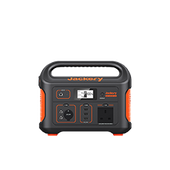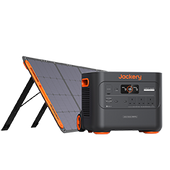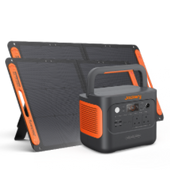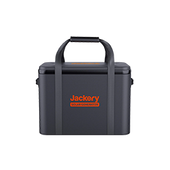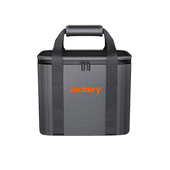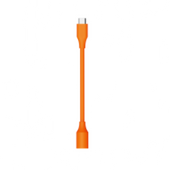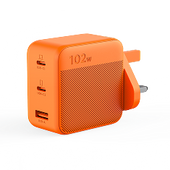Over the past years, the UK has experienced a major shift towards renewable energy. The UK's green energy production has increased from 14.6% in 2013 to 43% in 2020, as the government and individuals are now more focused on reducing their carbon emissions and dependency on traditional energy sources. Further, the country aims to generate 100% zero-carbon energy by 2035.[1]
This transition has made solar energy bank solutions a popular option for households and businesses seeking to embrace sustainable means of energy production.
But one question remains if you don't have a comprehensive grasp of solar energy: Is it worth buying a solar portable power bank in the UK?
In this article, we will explore the benefits, costs, and scenarios where owning a solar energy generator for house and business can make a significant difference in day-to-day life.
Basics of Solar Energy Bank Explained
1. What Is A Solar Energy Bank?
A solar energy bank is integral to a solar-powered energy production system, including the rooftop solar system, balcony solar system, and portable solar generator. It is a battery system that stores excess energy generated by PV panels during shiny days, which is beneficial on cloudy days and at night. It can be a large-scale system that can power an entire building or a mini-sized version designed to power personal electronics like mobile phones.
2. Types of Solar Energy Bank Cells
With different battery technologies, solar energy banks can utilise different battery cells. Generally, there are three types of battery cells widely used:
- Lead-Acid Batteries
Lead-acid batteries can be said to be the rechargeable battery that claims the longest history. They are typically popular in commercial solar setups because they are affordable and reliable. Lead-acid batteries offer reliable performance and can handle a wide temperature range, making them applicable for both hot and cold climates with proper safety features.
Generally, you can see two types of lead-acid batteries: flooded and sealed. Flooded batteries contain liquid electrolytes and require maintenance, while sealed batteries use sealed electrolytes and require little maintenance, which makes these batteries often referred to as maintenance-free batteries.
- Lithium-ion Batteries
Lithium-ion batteries have a more advanced system that allows users to store more energy within the battery. They are compact and lightweight and have a longer lifespan than lead-acid batteries. You can expect good service for 10 years or more.
They also offer fast charging, which is essential for a solar system, as sunlight hours are limited in the UK. Plus, you do not need to fully use the battery before recharging it. However, they are a bit costly and can also catch fire if not managed properly.
- LiFePO4 Batteries
LiFePO4 (Lithium Iron Phosphate) batteries are considered the best kind of batteries for solar systems. They use lithium iron phosphate (LFP) as the cathode component for better performance than other regular lithium batteries. They also have greater longevity and stability than traditional lithium-ion batteries.
They charge quickly and more efficiently, making them an ideal option for small devices and solar power systems. They consist of non-flammable electrolytes that reduce the chances of overheating and fire. Their overall exceptional performance makes them suitable for portable solar systems and various solar energy uses.
3. Features of a Solar Energy Bank
- Stable Load Backup
A solar energy bank offers a consistent power supply when solar panels are producing less energy due to low sunlight, nighttime, or during power outages. This backup storage is extremely beneficial for areas where weather conditions are unpredictable. It ensures you receive a stable power supply in times of power disruptions.
- Off-Grid Power Supply
A solar energy bank enables complete energy independence, allowing users to produce and store their own power. This feature makes it convenient for adventure lovers to explore the outdoors without cutting off from the world. Users can charge their devices and power their appliances even in the middle of nowhere. This feature also facilitates houses in remote or rural areas with unreliable grid connections.
- Scalability
Many solar energy banks feature modular designs. Therefore, users can start with a basic battery setup and gradually add additional battery packs as their energy needs grow. This scalability makes these energy banks highly adaptable, whether for small-scale uses such as powering personal electronics or large-scale systems for homes and businesses.
Is It Worthwhile Buying a Solar Energy Bank in the UK?
The answer is yes. A one-time investment in a solar energy bank can help you reap benefits for years. Let's examine the expected cost of owning a solar energy bank along with its long-term benefits so you can decide for yourself.
Costs and Other Factors to Consider:
- Solar Energy Bank Costs
In the UK, the cost of a solar energy bank varies mainly by capacity and battery type. Small systems less than 1 kWh typically cost you hundreds of pounds, while bigger battery systems (3-15 kWh) can cost you thousands of pounds and even up to 10,000 pounds. Typically, LiFePO4 batteries can be more expensive than lead-acid batteries due to their more complex manufacturing process and better performance.
Additionally, when it is a larger-scale battery energy storage system, you need a professional team to help with proper installation to ensure safe operation. This can further add to the cost of having a solar energy bank.
- Battery Maintenance Costs
Solar energy banks are generally designed to be low-maintenance, but it is important to be aware of potential battery replacement needs over time. Lead-acid batteries typically require replacement every 3 to 6 years, depending on usage and maintenance practices. Lithium-ion batteries, which are more durable and efficient, generally last longer, with replacement needed approximately every 10–15 years.
- Space Requirements
A solar energy bank system, especially a larger one, requires adequate space for both the battery and any accompanying equipment, such as inverters and control units. The owner must ensure they have the necessary indoor or outdoor space for installation, particularly if they opt for a high-capacity system.
- Battery Knowledge Learning
You may also need to put some effort into learning different batteries, from their respective pros and cons to basic battery maintenance and operation. This includes understanding charging cycles, safe storage conditions, and troubleshooting to ensure the system operates efficiently over time.
Benefits of Solar Energy Bank:
As a house or business owner, a solar energy bank offers great benefits. Some of those advantages include helping users save money and experience energy independence with lower environmental impact.
- Optimal Investment in Your Solar System
Pairing a solar panel system with a solar energy bank can allow users to save big on their energy production. The solar energy bank stores the excess energy produced during high sun times. That energy can be conveniently utilised at night or on cloudy days. This reduces your reliance on the main grid and allows you to maximise the consumption of energy from your solar system. Better, you can enjoy a reduced energy bill and gain a faster return on your solar investment.
- Energy Independence
Solar energy banks allow users to embrace energy independence whether they are at home or planning off-grid adventures. A power outage in case of emergency or bad weather can disturb the flow of your peaceful life, but a solar energy bank ensures you have a reliable backup in times of power outage. This system also allows you to plan outdoor events at places where the power supply is limited.
- Carbon Emission Reduction
When using a solar system, we are expecting to minimise our carbon footprints. A solar energy bank allows you to do so by reducing the use of grid power, which is largely generated through fossil fuel combustion. Especially, compared to other traditional power generation systems, a solar system with energy storage units is a green power solution that produces and utilises clean energy.
Jackery's Solar Power Stations: Powering Your Needs
If you are still unsure about what a solar energy bank can do, please take a look at the Jackery Solar Power Station series. Here, Jackery offers versatile power solutions for different types of energy demands. Our solar power stations are ideal for outdoor adventures, emergency backup power, and daily home and business uses. The following are two of our models for a stress-free power experience.
1. Jackery Explorer 1000 Plus Portable Power Station

If you are looking for a power station to meet moderate power needs, such as backup for home or outdoor camping, this is the best solar power bank, with an expandable power capacity ranging from 1264 Wh to 5 kWh.
This solar battery pack utilises high-quality LiFePO4 battery cells, featuring a portable, lightweight design best for camping, travelling, and other outdoor uses. Further, it is compatible with the Jackery SolarSaga Solar Panel to be a solar panel power bank that can be fully charged in 2 hours. Its multiple output options, including AC outlets and USB ports, ensure it can power various devices and appliances conveniently.
2. Jackery Explorer 2000 Plus Portable Power Station

If you need a bigger electricity-producing solution, the Jackery Explorer 2000 Plus Portable Power Station is your best bet. It is best for home backup or large off-grid setups, with an impressive expandable capacity ranging from 2 kWh to 12 kWh.
It also utilises LiFePO4 batteries with leading technologies that can support fast solar charging in 2 hours with 6 Jackery SolarSaga 200W solar panels. As with any other Jackery portable solar power station, this solar energy bank supports multiple charging methods, from wall charging to carport charging. Better, you can expect the battery to provide reliable performance for up to 10 years.
FAQs About Solar Systems in the UK
1. Is the UK Sunny Enough To Let Solar Systems Work?
Although the UK is better known for rainy and cloudy weather, it can still benefit from solar power, and some regions are specifically good for solar power utilisation, like Eastbourne in East Sussex, Bognor Regis in West Sussex, and South West England. Take Eastbourne, East Sussex, as an example. This region enjoys an average of 1,762 hours of sunshine each year from 1991 to 2020.[2]
2. How Long Does A Solar Energy Bank Last? What About Solar Panels?
A solar energy bank can usually last 5 to 15 years. Its service life also depends on the type of battery and maintenance. Lithium batteries typically have a longer lifespan. On the other hand, solar panels can usually last 25 to 30 years. They degrade slowly and remain effective for decades.
3. What Should I Consider When Choosing A Solar Energy Bank?
When choosing a solar energy bank, carefully consider factors like battery capacity, battery type, portability, and compatibility with solar panels. For instance, lithium-ion batteries are more durable and efficient than lead-acid batteries. Also, consider the portability of your solar energy bank if you frequently plan outdoor trips. Consider your energy needs, such as whether you need it as backup power or for camping and off-grid situations.
4. How to Use and Maintain My Solar Energy Bank Properly
Check the instruction guide that comes along with the solar power bank. Usually you can start to use it by simply connecting it to the solar panels and plugging in the devices that you want to power through its outlets.
As for maintenance, make sure the batteries are clean and place them in a dry, cool environment. Avoid overcharging or completely draining the battery to extend its lifespan. Check for updates if required and perform routine inspections to ensure proper functioning. For long-term use, follow the manufacturer's guidelines on charging cycles and storage.
Conclusion
Investing in a solar energy bank is a worthwhile investment in the UK. This advanced green power solution offers a unique chance to enjoy energy independence, reduce carbon emissions, and contribute to the collective aim of creating a greener, healthier environment.
Feel free to explore Jackery for more solar power solutions. From the 99 Wh LiFePO4 battery system offering 128 W output to a 12 kWh system supporting 3000 W output, Jackery power stations can help you stay powered in different scenarios!
Reference Links:
[1] National Grid/2024, "How much of the UK's energy is renewable?". Available at: https://www.nationalgrid.com/stories/energy-explained/how-much-uks-energy-renewable (Accessed on October 17, 2024)
[2] Met Office, "Historic station data". Available at: https://www.metoffice.gov.uk/research/climate/maps-and-data/historic-station-data (Accessed on October 18, 2024)






